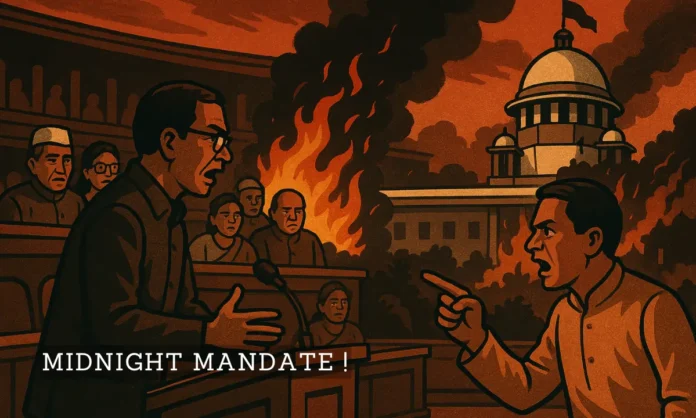Summary
- Shashi Tharoor’s early-morning speech underscores the surreal timing of a major constitutional shift amid rising public apathy toward parliamentary procedures.
- Manipur President’s Rule 2025 follows 21 months of ethnic unrest, with deep-rooted social fractures and questions over central neglect.
- As political parties clash over accountability and healing, the symbolic weight of midnight legislation reopens national debates on federalism and forgotten frontiers.
1. When 90% of India was sleeping, BJP govt brought motion at 2 AM to approve Presidents rule in Manipur
— Amock_ (@Amockx2022) April 3, 2025
13 hours of debate on Waqf bill and then they smartly did this to avoid any headlines on Manipur 🫡
No debates, No discussions, No agitation. pic.twitter.com/VHinOB9w2l
When Democracy Sleeps, Parliament Stirs
At 2 AM on April 3, 2025, while most of India was fast asleep, the Lok Sabha passed a motion approving the imposition of President’s Rule in Manipur. What might have been a routine procedural endorsement turned into an uncanny political spectacle: dimly lit chambers, weary lawmakers, and Shashi Tharoor—one of Parliament’s most articulate voices—rising to speak about a state many had stopped talking about.
Tharoor, representing the Congress party, called the moment “unusual,” not just for its nocturnal setting, but for what it represented: a country reaching belatedly for constitutional repair after nearly two years of turmoil in its northeast.
The Manipur President’s Rule 2025 resolution was passed in just 41 minutes, bookended by protests over the Waqf Bill and a visibly fatigued treasury bench. But behind the procedural speed lay decades of social neglect, political missteps, and strategic silences.
A Forgotten State Reaches Breaking Point
- Manipur has seen 11 instances of President’s Rule—more than any other Indian state in post-independence history.
- The 2023–2025 unrest resulted in at least 250 deaths and mass displacement, according to statements in Parliament.
- Ethnic clashes between Meitei and Kuki-Zomi communities reignited old tensions around land, identity, and political representation.
- Internet shutdowns, militarization, and loss of governance legitimacy worsened public trust over 21 months.
- Central and state governments were accused of inertia until the crisis reached national headlines and judicial scrutiny.
The announcement of Manipur President’s Rule 2025 was not a surprise. For months, calls for administrative overhaul had grown louder amid allegations of targeted violence, inadequate relief, and a state government seen as partisan in a conflict that had ethnic roots.
Tharoor’s speech, short but sharply focused, captured this failure: “We’ve all witnessed the horrors of Manipur,” he said, describing the violence as “a slow-burning horror.” The use of President’s Rule, in his words, must now be seen as a “healing opportunity.”
But healing requires more than orders from Delhi—it demands a reckoning with what went wrong.
Procedural Theater or Political Bypass?
- The Lok Sabha passed the President’s Rule resolution in the early hours, immediately after debating the controversial Waqf (Amendment) Bill 2025.
- Minority Affairs Minister Kiren Rijiju and Home Minister Amit Shah both defended the timing, calling it “necessary for legislative continuity.”
- Congress backed the motion, but questioned the delay in action and the broader parliamentary process.
- Critics argue that high-stakes decisions being passed at night reflect democratic fatigue and procedural cynicism.
- The event has reignited debate over legislative transparency, especially for decisions affecting far-flung or marginalised regions.
What does it say about a democracy when laws governing 3.2 million people are passed as the clock nears dawn?
The symbolism was not lost on observers. “Ignore the hubbub at the start,” Tharoor remarked in his now-viral post on X, “from members protesting the unearthly hour.” But for many, the timing was emblematic of how India treats its northeast—as an appendage, not a priority.
Even as the Waqf Bill passed with 288 votes in favour and 232 against, the room was thin, weary, and emotionally removed from the gravity of Manipur’s situation. When Home Minister Amit Shah wrapped up his defence of the resolution in just nine minutes, it felt like closure without context.
This kind of “midnight legislation” is not new. But its increasing normalisation—whether for contentious reforms or emergency measures—raises questions about the nature of participatory governance in India’s 21st-century democracy.

The Ethnic Volcano Beneath the Peace Rhetoric
- The Meitei–Kuki conflict at the heart of Manipur’s unrest is rooted in land access, Scheduled Tribe status, and historical grievances.
- Illegal immigration from Myanmar, drug trafficking, and ethnic militancy have complicated ground realities.
- Manipur’s economy remains underdeveloped, with weak infrastructure and low industrial employment opportunities.
- Critics say repeated use of President’s Rule addresses surface instability but not the root causes of alienation.
- Activists and civil society groups have demanded dialogue-driven federal solutions rather than top-down enforcement.
At its core, the Manipur President’s Rule 2025 is not just a bureaucratic intervention—it is a verdict on failure. Not just of the state government, but of India’s larger governance model in conflict-prone peripheries.
Tharoor acknowledged this when he pointed to the underlying social challenges: underdevelopment, limited industrialisation, and a youth population with few options beyond migration or militancy. Drug cartels, cross-border smuggling, and splinter insurgent groups all thrive in this governance vacuum.
The recent spike in communal distrust—fueled by digital misinformation and real economic pain—has made the old political pacts unsustainable. While the use of Article 356 may restore administrative discipline, the risk is that it might also silence local voices further.
Midnight Law, Morning Reckoning
For most Indians, the northeast remains distant—geographically, emotionally, politically. But at 2 AM in Parliament, as voices echoed across empty benches and digital posts tried to make sense of what just happened, something shifted.
Maybe not policy. Maybe not even priorities. But perhaps the beginning of national attention.
Because in that speech, Shashi Tharoor did more than comment on timing. He captured a state’s cry for visibility. And in doing so, reminded the country that no democracy is complete if its pain can only be discussed when the world is asleep.


